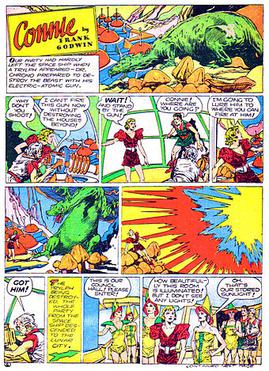Connie (comic strip)
Appearance
This article needs additional citations for verification. (October 2011) |

Connie is an American adventure comic strip created by the cartoonist Frank Godwin, who introduced a book illustration style to the comics page. The strip ran from 1927 to 1944 for the Ledger Syndicate. Connie debuted as a Sunday page on November 13, 1927.
Characters and story
The strip evolved as Connie Kurridge went through various situations and occupations, including aviator, stunt pilot, charity worker, reporter and detective. Villains were fooled by her beauty and underestimated her agility and resourcefulness. Comics historian Don Markstein commented:
- When Connie's daily strip began, on May 13, 1929, she became "flighty" in a different sense. There, she was played as an adventuring aviator, and the strips her series fit right in with included Tailspin Tommy, Skyroads and the early Brick Bradford—except, of course, for her gender. Connie was the first female adventure hero in American comics, the precursor to Brenda Starr, Deathless Deer, Modesty Blaise and all the rest. Connie (last name Kurridge—sounds like "courage", get it?) was deceptively pretty, tho as a product of the flapper era, rather flat-chested compared to modern comics women. Neither villains nor readers back then expected to find an agile and resourceful brain beneath her lovely blonde curls. And she was capable of spectacular feats of derring-do, such as flying great distances cross-country in an unfamiliar plane, at night, with neither navigational equipment nor lights; or performing stunt flights in a plane she knew had recently been sabotaged.[1]

In The World Encyclopedia of Comics, Maurice Horn wrote:
- Then came the Depression and Connie turned out to be a girl with a social conscience; she helped her mother with her charity work and often visited the men on the bread lines (one of the very few instances where the Depression was graphically depicted in a comic strip)... In 1934 Connie went to work, first as a reporter, then as the operator of a detective agency (a kind of female Sam Spade)... Connie is a liberated woman: intelligent, self-reliant, at ease in all situations. Holding her own against any man, she would certainly have made a better representative for the women's movement than... Wonder Woman.
Reprints
The strips were reprinted in Famous Funnies.
References
- ^ Markstein, Don. Toonopedia: Connie
Sources
- "Lambiek.net". Lambiek.net. Retrieved 2007-08-30.
